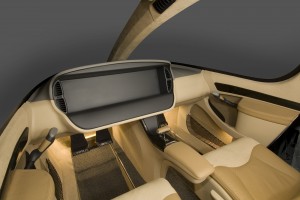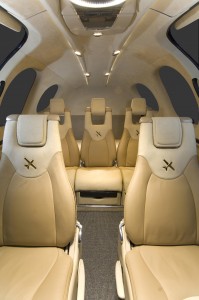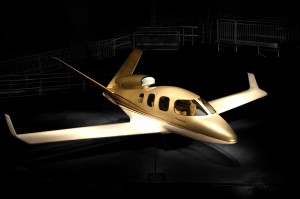
The cockpit of the-jet seems to favor a single pilot operation with instruments clustered toward the left. Sidesticks will move the control surfaces and the wide rudder pedals will be comfortable for any foot.
By Henry M. Holden
On June 28, Cirrus Design Corporation of Duluth, Minn., unveiled its latest design—a personal jet. Introduced in mock-up stage only, its single-engine V-tail jet, called “the-jet,” is the most anticipated aircraft in the company’s history.
“We’re calling it a personal jet, not because of its size, but because it’s a natural extension of our SR22 line,” said Alan Klapmeier, Cirrus co-founder and CEO. “Like the SR22, the-jet is designed to be owner-flown. It will be loaded with innovative features.”
Klapmeier emphasized that the personal jet distinguishes itself from the pack of very light jets now appearing on the market. When compared to those aircraft, he said the-jet will be easier to fly for the nonprofessional pilot, and clearly the next step up for the Cirrus SR22 or other piston aircraft pilots.
“While the-jet is technologically advanced, it’s designed to be exceptionally easy to fly, offering customers the opportunity to grow into yet another lifestyle change with Cirrus,” Klapmeier said.
Closely-guarded secret
Cirrus has kept this project under wraps for several years.
“We’re still in the early design and development phase and didn’t want to limit ourselves in any way,” explained Dale Klapmeier, co-founder and vice chairman. “It was also important that any data we released was absolutely accurate.”
He said Cirrus will announce more details and release more information upon finalization. Mike Van Staagen, vice president of advanced development, said the information they’ve tried to protect during the past years of product development was the unusual amount of versatility and flexibility, such as the adaptability of the cargo configuration that has been incorporated into an airplane of this size.

The cabin is spacious, and the flight deck offers modern amenities for the pilot and passengers. The middle seat slides back for more legroom.
“This flexibility is even more surprising, given this airplane is designed specifically for a single owner/operator,” he said. “The design is precisely configured to maximize flexibility for the owner. Mountain bikes, camping equipment, golf clubs, skis, bigger families, antique spinning wheel? No problem! The-jet will deliver more value, because its cavernous interior accommodates very diverse usage.”
The company’s tight control of the project reached to its employees. Those who weren’t directly working on the project weren’t able to see the-jet until hours before the unveiling for select customers, the night before the public announcement. These customers had each placed a $100,000 deposit for the first personal jet in this new market.
Jet age takes on a new meaning
Cirrus believes that the new, emerging class of personal jets will create and fulfill a market sector—the area between high performance single-engine airplanes and the very light jet class. The personal jet follows the Cirrus philosophical path to grow and enhance the entire personal aviation industry.
“So far, we can confirm the-jet will be powered by a quiet, efficient and lightweight Williams jet engine that will give the aircraft great utility, economy and simplicity never before seen in the personal jet market,” Alan Klapmeier said. “A personal jet is about more than power; it’s about empowering our customers to live the dream of the jet lifestyle.”
Cirrus has chosen to release only selected details at this time.
“The Cirrus personal jet will be a brilliant execution of ingenious design,” Klapmeier said. “What you can expect from us is a jet that’s simple to fly and easy to operate in a variety of new and formerly challenging environments. Passengers and pilots will find the entire experience to be comfortable and intuitive, with a cockpit and cabin layout designed to maximize space in a sanctuary of luxury and safety. Simplicity of design assures that man and machine blend in unity, providing a jet that is uncomplicated to operate and inexpensive to own.”
Comfort and flexibility
In its normal configuration, the-jet will hold five passengers. A unique three-abreast rear seat allows for sufficient elbowroom. Because of the design, tall passengers traveling in the back seat will have plenty of room to stretch out with the seats reclined.
Although the-jet is similar in size to many four- and five-place jets, the cabin has the flexibility to hold up to seven. It will be a bit tight, comfortable if the two additional passengers are small adults or children, who will sit behind the rear seat.
With seven people aboard, the plane won’t go as far or as fast as it would with only one person onboard, but Alan Klapmeier says that is the beauty of the design.
“It’s all about flexibility,” he said. “If the typical use of Cirrus’ piston products is any guide, much of the-jet’s time will be spent carrying one or two people.”
Topside engine
Mounting the engine on top of the fuselage allows easier access for maintenance and easy load balancing. Turbine blade containment, in the event of a thrown compressor blade and fire, are also minimized. The V-tail allows a pathway for thrust from the Williams FJ33 turbofan, expected to push the-jet to about 300 knots.
“The engine is mounted on the aircraft’s back with a 20-degree slope, and the thrust is vectored to point it in the right direction,” says Alan Klapmeier. “Big straight wings with large control surfaces will make the aircraft easy to fly.”

Alan Klapmeier says the big, straight wings will make the-jet easy to fly. Those who hate to climb over or between seats to board aircraft will welcome the two full-sized doors. The sleek aerodynamic styling will help achieve 300 knots.
The placement of the engine did cause a design issue; it occupies space normally taken by the whole-airplane parachute that is standard on all Cirrus piston airplanes. Cirrus engineers resolved the issue by placing the chute in the nose, with the straps ripping up through the center division of the windshield.
The aircraft also has extensive winglets, which will enhance aileron influence at slow speeds and boost fuel efficiency.
The mock-up seems to emphasize that this is a single-pilot aircraft by clustering the instruments toward the left side. A full glass panel will be standard. When the-jet does fly, it will be pressurized to 25,000 feet.
Excellent short field performance and the ability to land on grass strips are two items Alan Klapmeier wants in the aircraft. He’s hoping to market the-jet for around $1 million, but some variables may affect the final figure.
“Like our best-selling SR20 and SR22 airplanes, it will be advanced, innovative and designed to the very core to be easy to fly,” he said. “And like any revolutionary engineering idea that proves itself time and again, it will also come equipped with the security of an airframe parachute. There will be many significant enhancements— most notably, a jet engine.”
Klapmeier is adamant about one thing in particular.
“Put your confidence in Cirrus!” he said. “We’ll deliver to you a personal jet that will exceed your expectations.”
For more information, visit [http://www.the-jet.com].











